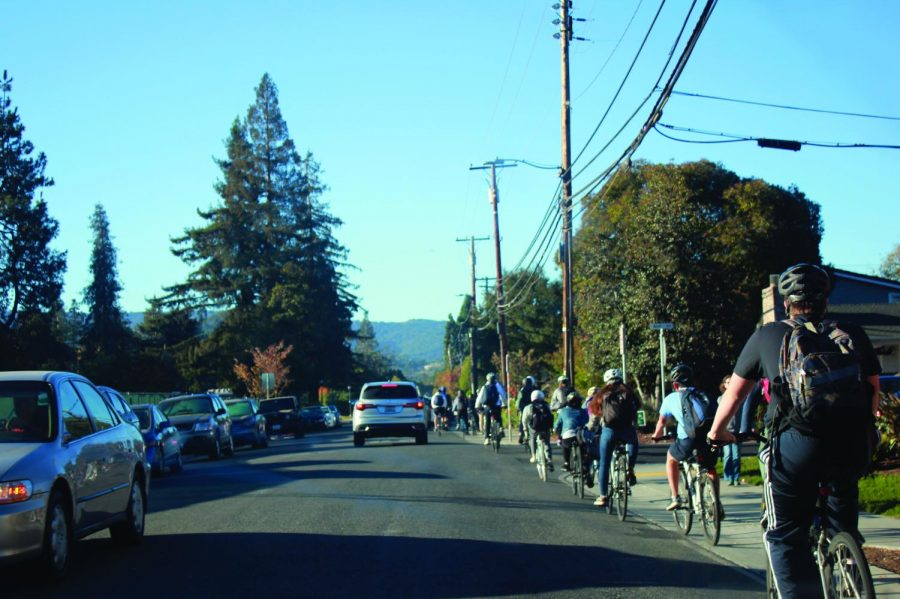Commuters clash: car-biker conflicts spark frustration
Bike safety and transportation have been long-time points of contention for Palo Alto residents and commuters. The City of Palo Alto has spearheaded several initiatives to monitor traffic and increase transportation safety throughout the years, dating back to the creation of its first bike boulevard on Bryant Street in the 1980s.
Previously, the City of Palo Alto implemented the Safe Routes to School program to improve safety for commuters and reduce school-related traffic congestion. The Safe Routes to School program includes a partnership with the Palo Alto Unified School District and the Palo Alto Parent Teacher Association. The partnership created a five-year plan to reduce the risk for students en route to and from school. Additionally, the City adopted the Palo Alto Bicycle & Pedestrian Transportation Plan in 2012, which identifies city goals for bicyclists and pedestrians. The plan includes the goal of expanding bicycle-to-work trips by 15 percent by 2020.
In 2012, the City also started reducing road lanes in order to moderate car traffic in the area. Long-time Palo Alto resident Charles Cedric Kinyon believes the reduction of lanes has actually been a large factor in traffic and bike safety issues. “People have to merge so many times,” Kinyon said. “I’ve seen people try to merge that are in the bike lane and people drive around in the middle lane when they are not supposed to. [Cutting] it down to two lanes caused a bigger problem than they thought it would be fixing.”
Currently, the City of Palo Alto is continuing its initiatives through the current Charleston/Arastradero Corridor Project, which aims to expand safety measures on roads and crosswalks. The Charleston/Arastradero Corridor Project, which began construction in June 2018, includes several additions to roads and crosswalks to improve safety for cyclists and pedestrians. Changes will work to moderate car speeds and improve sightlines for bikers and drivers. Certain street markings and features will serve to create a protective buffer between cyclists and motorists, including a one-way protected cycle track installed on Arastradero Road which will separate parked cars from the bike lane. Additionally, median refuge islands that allow pedestrians and bicyclists to be protected when crossing a larger street and waiting for a gap in vehicle traffic will be installed on several intersections.
The construction for this project caused a temporary narrowing of roadways around Gunn due to barricades and cones being used for the safety of construction crews. Junior Maximilian Goetz believes this inconveniences both bikers and drivers. “There are a lot of places where you have to share the road,” Goetz said. “For a novice biker to have a car going behind you at 25 mph, you feel pressured to bike faster since you don’t want to hold them up.” Goetz believes bikers should redirect to Maybell Avenue and other side streets during construction. “Try to avoid biking and driving on Arastradero if you can,” he said.
Senior Adam Lehot believes the solution to bike safety issues is better enforcement of traffic laws. “The biggest problem is that kids don’t stop at stop signs and always take up the entire road, sometimes going into oncoming traffic,” he said. Lehot says that a solution to this problem is to have more police officers on patrol during commute times. “Whenever they have cops the bikers always behave,” Lehot said. “I don’t understand why there isn’t at least one police officer in the general area of three schools. Palo Alto has one of the lowest crime rates ever and they can’t post one officer to patrol the general area of all these schools?”
According to Officer Chris Moore of the Palo Alto Police Department, patrol officers monitor school transportation safety around Palo Alto daily. “Every patrol officer that is on duty that day is supposed to spend an hour in the morning doing school safety stuff,” Moore said. “It’s mostly looking at cars that don’t drive safely and making sure people wear their helmets.”
Moore warns bikers of the importance of following the rules of the road. “Usually bicyclists don’t follow all the road rules” Moore said. “They need to remember that while on the crosswalk they are a pedestrian, and when they are on the street they are a car so they have to follow all the rules.”
Your donation will support the student journalists of Henry M. Gunn High School. Your contribution will allow us to purchase equipment and cover our annual website hosting costs.




